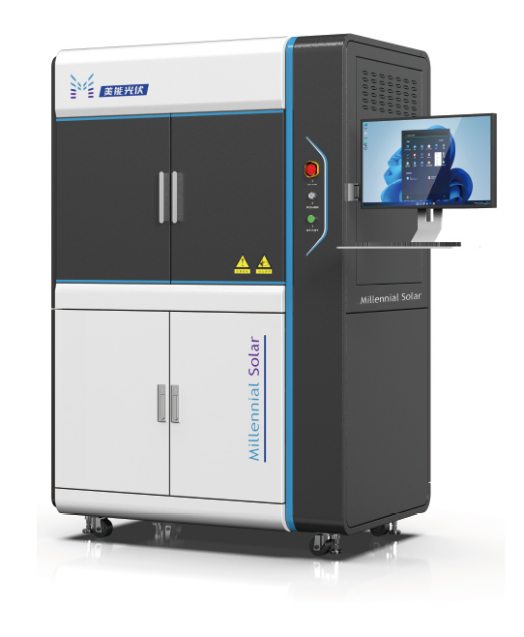
量子效率测试仪
PL/EL一体机
Sinton硅片少子寿命测试仪
Sinton硅块少子寿命测试仪
绒面反射率测试仪
3D共聚焦显微镜
在线四探针方阻测试仪
全自动扫描四探针方阻测试仪
在线薄膜厚度测试仪
晶化率测试仪
Horiba显微共焦拉曼光谱仪
傅里叶红外光谱仪
霍尔效应测试仪
分光光度计
全光谱椭偏仪
Horiba椭圆偏振光谱仪
TLM接触电阻率测试仪
超景深显微镜
网版智能影像测量仪
全自动影像测量仪
卧式拉力机
电池片稳态光衰老化试验箱
电池片紫外老化试验箱
电池片拉脱力综合测试仪
外观检验台
湿漏电测试系统
组件实验室EL测试仪
紫外老化试验箱
稳态光衰老化试验箱
电流连续性监测系统
PID测试系统
旁路二极管测试系统
LeTID测试系统
反向电流过载系统
脉冲电压测试系统
绝缘耐压测试仪
接地连续性测试仪
绝缘耐压接地测试仪
湿热环境试验箱
湿冻环境试验箱
热循环试验箱
动态机械载荷测试机
静态机械载荷测试机
冰雹冲击试验机
引出端强度试验机
霰弹冲击试验机
抗划伤(切割)测试机
剥离试验机
万能材料试验机(单臂)
万能材料试验机(双臂)
光伏玻璃透过率测试仪
醋酸测试试验箱
交联度测试系统
二极管接线盒综合测试仪
落球冲击试验机
半自动四探针
全自动探针式台阶仪
多通道太阳能MPPT系统
Horiba稳瞬态荧光光谱仪
钙钛矿P1激光划线测试仪
钙钛矿在线PL测试仪
钙钛矿在线方阻测试仪
钙钛矿在线膜厚测试仪
钙钛矿工艺检测工作站
手持式IV测试仪
便携式EL测试仪
手持热成像测试仪
户外组件多通道测试系统
光伏逆变器电能质量测试仪
无人机EL检测仪
美能光伏科普 | 适用于太阳能电池的多种量子效率检测方法
日期:2023-10-25浏览量:45
由于具体情况的不同,电池厂商在检测太阳能电池的量子效率时都会根据实际情况进行具体分析,从而经常会使用多种量子效率检测方法进行检测。「美能光伏」凭借独特的科学技术生产了美能量子效率测试仪,该设备可适用多种太阳能电池,并对太阳能电池的光谱响应偏差问题进行科学诊断,从而助力电池厂商高效生产和有效优化!本期「美能光伏」将给您介绍适用于太阳能电池的多种量子效率检测方法!

![]()
单色光法
单色光法是一种绝对测量方法,它不需要有参考对象的标准样品,而是通过测量太阳能电池在单色光照射下的短路电流来计算其量子效率。运用单色光法对太阳能电池片进行量子效率检测,是使太阳能电池在单色光照射下产生的短路电流与入射光子数成正比,因此可以通过测量不同波长下的短路电流来得到不同波长下的量子效率。该方法可以准确、可靠的检测太阳能电池的量子效率与光谱响应大小,并可用于检测各种类型的太阳能电池。
![]()
外量子效率/eqe法
外量子效率法也被成为积分球法,是一种相对测量方法,它需要一个与待测的太阳能电池相似且量子效率已知的标准样品作为参考,从而将待测太阳能电池和标准样品分别放置在积分球内,通过测量它们在白光照射下的反射、投射和吸收比例,计算出待测太阳能电池的量子效率。

![]()
双波长法
双波长法与单色光法类似,是一种绝对测量法,它不需要有参考对象的标准样品,而是通过测量太阳能电池在两个不同波长下的短路电流来计算其量子效率。双波长法可使太阳能电池在两个不同波长下产生的短路电流之比与入射光子数之比成正比,再通过插值或外推法,便可以得到其他波长下的量子效率。使用双波长法进行量子效率检测,只需要两个波长点就可以得到整个波长范围内的量子效率曲线,从而消除温度、接触等因素对测量结果的影响。

![]()
模拟太阳光法
模拟太阳光法同积分球法有些类似,需要一个待测太阳能电池相似且量子效率已知的标准样品作为参考。将待测样品和标准样品分别放置在模拟太阳光源下,通过测量它们的短路电流和开路电压,计算出待测太阳能电池的量子效率。
![]()
美能量子效率测试仪—— 适用于众多测量方法的精密仪器
「美能光伏」生产的美能量子效率测试仪在检测太阳能电池的量子效率时,可对太阳能电池的量子效率进行科学性诊断,从而生成实时光谱分布图,对太阳能电池的光谱偏差进行检测。光伏企业用户可根据自己的具体情况,选择最优的测量方法,并通过美能量子效率测试仪所具有的测量结果数据分析和光谱分布图,便可一目了解的发现光谱响应是否在产业化检测标准的阈值当中,从而进行留强汰弱性的调整与优化!

商务联系:张经理 400-008-6690
美能量子效率测试仪可用来测量太阳能电池的光谱响应,并通过其量子效率来诊断太阳能电池存在的光谱响应偏低区域问题。设备因其普遍的兼容性、广阔的光谱测量范围、测试的准确性和可追溯性等优势,受到了光伏企业用户的热烈追捧!
● 可完美适用于所有光伏器件
● 光谱范围可从300-1100nm到250-3000nm
● 全自动检测并直接生成光谱响应
● 偏置光可在1x1cm范围产生均匀照明
在对太阳能电池进行量子效率检测时,不管运用哪种方法,实施怎样的检测操作,其检测的目的都是想评估太阳能电池的性能,从而帮助光伏企业用户对其进行提升。「美能光伏」生产的美能量子效率测试仪,可对太阳能电池进行光谱响应偏差检测。未来,「美能光伏」还将继续秉承服务与技术并存的理念,奋楫前行、笃行不怠!





































































